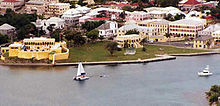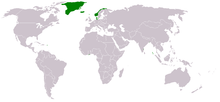- Danish colonization of the Americas
-
European colonization
of the AmericasFirst colonization British colonization Courlandish colonization Danish colonization Dutch colonization French colonization German colonization Norse colonization Portuguese colonization Russian colonization Scottish colonization Spanish colonization Swedish colonization Colonization of Canada Colonization of the USA Decolonization Denmark and the former political union of Denmark–Norway had a colonial empire from the 17th through the 20th centuries, large portions of which were found in the Americas. Denmark and Norway in one form or another also maintained land claims in Greenland since the 13th century.
Contents
Greenland
Main articles: Greenland and History of GreenlandSee also: Norse colonization of the AmericasGreenland, which had been settled by the Norsemen in the 980s,[1] submitted to Norwegian rule in the 13th century. Norway entered into the Kalmar Union with Denmark and Sweden in 1397, and its overseas territories including Greenland became territories of the Union.[2] Scandinavian settlement in Greenland declined over the years and finally vanished in the 15th century, though the Norwegian claims to the land remained. After the Kalmar Union split in 1521, Norway and Denmark reorganized into Denmark–Norway in 1536, and the Norwegian claims to Greenland were taken up by the new kingdom.
Despite the decline of European settlement and the loss of contact, Denmark–Norway continued to maintain its claim to lordship of Greenland; in the 1660s a polar bear was added to the royal coat of arms. Around this same time Dano-Norwegian ships, joined by ships from various other European countries, began journeying to Greenland to hunt bowhead whales, though no formal recolonization was attempted.
In 1721, Lutheran minister Hans Egede sought permission from King Frederick IV to seek out the old Norse colony, presuming that if it still existed it would have remained Roman Catholic after the Protestant Reformation, or else abandoned Christianity altogether. Frederick consented to at least a partial colonization attempt, and Egede set out to evangelize the island. He found no Norse survivors, but did encounter the Inuit and started a mission among them. Founding the settlement of Godthåb (now Nuuk), he baptized the first children in 1724. In 1730, the new king Christian VI recalled all Europeans from Greenland, but Hans Egede, encouraged by his wife Gertrud, remained, opening the way for further settlement and trade. After 15 years in Greenland, Hans Egede left his son Paul Egede in charge of his mission in Greenland and returned to Denmark where he established a Greenland Seminary. In 1733, German missionaries from Herrnhut, followers of the reformer Nicolaus Ludwig Zinzendorf, were allowed to found the settlement of New Herrnhut south of Nuuk.
In 1814, Norway was separated from Denmark by the victors of the Napoleonic Wars and granted to Sweden at the Treaty of Kiel. Denmark retained all colonial possessions, including Greenland. Beginning in 1861, Denmark allowed elections for district assemblies in Greenland, but most decisions were made by the Danish parliament, in which the Greenlanders had no representation. Discoveries made by the American explorer Robert Peary in the 1880s and 1890s were used as the basis for territorial claims by the United States; these land disputes were settled with the American purchase of the Danish Virgin Islands in 1917. Additionally, Norway, which gained full independence from Sweden in 1905, challenged Danish claims to Greenland and supported the occupation of uninhabited eastern Greenland by the Norwegian whaler Hallvard Devold in 1931, calling the area Erik the Red's Land. In 1933, the Permanent Court of International Justice ruled in Denmark's favor.[3]
In 1953, Denmark lifted Greenland's colonial status and elevated it to an integral part of the Kingdom of Denmark with representation in the Folketing. In 1979, Greenland was granted home rule by the Folketing. In 2009 full control of all matters not concerning defense and foreign policy was transferred to Greenland. Greenland remains a part of the Kingdom of Denmark.
West Indies
 Christiansted, Danish West Indies
Christiansted, Danish West Indies Main article: Danish West Indies
Main article: Danish West IndiesExplorers (mainly Norwegians), scientists, merchants (mainly Danish) and settlers from Denmark–Norway took possession of the Danish West Indies (present-day U.S. Virgin Islands) in the late 17th and early 18th centuries.
Denmark started colonies on St. Thomas in 1672 and St. John in 1683 (though control of the latter was disputed with Great Britain until 1718), and purchased St. Croix from France in 1733. During the 18th century, the Virgin Islands in the Caribbean Sea were divided into two territorial units, one British and the other Danish–Norwegian. The Danish–Norwegian islands were run by the Danish West India and Guinea Company until 1755, when the Danish–Norwegian king bought them out.
Sugar cane, produced by slave labor, drove the islands' economy during the 18th and early 19th centuries. A triangular trade existed with Danish manufactures buying African slaves which in turn were traded for West Indian sugar meant for Denmark. Although the slave trade was abolished in 1803, slavery itself was not abolished until 1848, after several mass slave escapes to the free British islands and an ensuing slave protest. The Danish Virgin Islands were also used as a base for pirates. The British and Dutch settlers became the largest non-slave groups on the islands. Their languages predominated, so much so that the Danish government, in 1839, declared that slave children must attend school in the English language. The colony reached its largest population in the 1840–50s, after which an economic downturn increased emigration and the population dropped, a trend that continued until after the islands' purchase by the United States. The Danish West Indies had 34,000 inhabitants in 1880.
In 1868, the islanders voted to sell the colony to the United States but their offer was rebuffed. In 1902, Denmark rejected an American purchase offer. In 1917, the United States purchased the islands, which had been in economic decline since the abolition of slavery.
References
- ^ The Fate of Greenland's Vikings, by Dale Mackenzie Brown, Archaeological Institute of America, February 28, 2000
- ^ Boraas, Tracey (2002). Sweden. Capstone Press. p. 24. ISBN 0-7368-0939-2.
- ^ Legal Status of Eastern Greenland, PCIJ Series A/B No. 53 (1933)
See also
External links
Categories:- Former Danish colonies
- Colonization of the Americas
- History of the United States Virgin Islands
Wikimedia Foundation. 2010.

